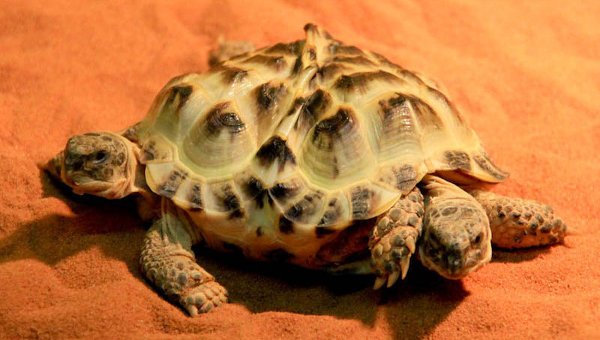
A two-headed tortoise with two hearts and six legs has gone on show on Friday at the exhibition called Live Dragons at a natural science museum in Kiev, Ukraine.
The 5-year-old Central Asian steppe turtle with two heads and six paws is displayed as part of the exhibition at the Science History Museum in Kiev. The Ukrainian-born reptile, on display at the museum, has a heart-shaped shell about a dozen centimetres (4.7 inches) in width.
Visitors will be able to observe the different eating habits of each head over the next two months.
The organizer of the project Dmitry Tkachev said: “This turtle is a mutation.”
According to Dmitry Tkachev, the tortoise was born to a breeder of the animals in Ukraine, “in the wild, animals with such mutations rarely survive.”
Dmitry Tkachev went on to explain that the heads of the unusual turtle can’t see each other, “each has its own character, so they often want to crawl in different directions.”
“Strictly speaking it isn’t a tortoise with two heads, but rather two conjoined tortoises,” Yuri Yuravliov, a zoologist, told AFP.
“The female has two heads, two hearts, four front legs, but only two hind ones, and one intestine,” Yuri Yuravliov explained.

The two heads are quite different, even in their feeding habits.
The left one is more dominant and active, “prefers green food, while the other prefers more brightly-colored food – carrots and dandelion flowers,” said Yuri Yuravliov.
The tortoise, a species that can live 50 to 60 years, was kept from birth by a Ukrainian in his home, he said.
“Animals with this type of pathology are only rarely born and don’t survive in natural condition.”
Sergei Ryabov, head of the center that studies reptiles, said that each of the heads of this unusual reptile had its own favorite food.
“One eats everything but prefers green leaves, if you offer it a choice it will eat only green, but this one does not eat leaves at all and eats only red or colorful things, like peppers or carrots,” Sergei Ryabov said.
The two-headed turtle can be seen in the natural history museum of Kiev until April 20.